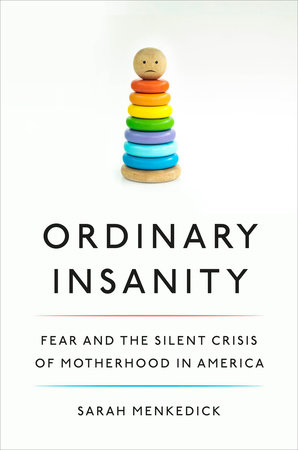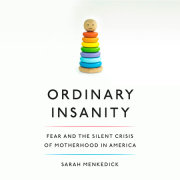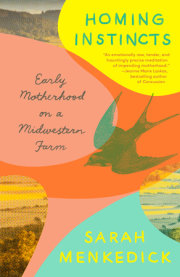FOR ME, IT BEGAN WITH MOUSE POOP. We lived in a nineteenth-century cabin, so mouse poop should not have been an anomaly. I’d brushed it aside before, but then one day anxiety lit it up. Like a virtuoso author of magical realism, anxiety infuses everyday objects with great power. Suddenly the mouse poop glowed with threat and I couldn’t unsee it. I turned to the contemporary wizard of Google to learn my fate: was it innocuous, or could it kill my baby? It could kill my baby. There was a vanishingly small but devastating chance that mouse poop could transmit congenital CMV, one of the many conditions that barely arouse a cough in an adult woman but can destroy the brain of a fetus. The Google hive of experts warned against coming into contact with it.
This is when I first felt that hot tingling of horror. It was like swallowing a spoonful of cayenne pepper and then feeling it shiver through the veins, pickle the stomach, sear the heart. I went on a cleaning frenzy that lasted for the next nine months. I stored bottles of Seventh Generation Disinfecting Multi-Surface Cleaner as if they were the sole line of defense between me and a looming invasion. I coated every surface in a layer of sticky, mint-reeking gunk.
Telling the story of my anxious episodes is a bit like an alcoholic recounting blackouts: they all follow the same pattern, becoming increasingly disturbing and severe, monotonous in their arc but gruesomely compelling in their details. Thinking always of my baby, I was afraid of the mouse droppings, glyphosate in Quaker Oats, the toxins given off by our new mattress, the microwave, fracking chemicals in the air, fracking chemicals in the water, preservatives in granola, synthetic fabrics. That’s just a small selection. Meanwhile I ate peanut butter pie piled with whipped cream. I drove on sinuous country roads laced with ice. I cried a lot. I isolated myself from the world. I took risks, even big risks, but I did not see them as risks because I was fixated on toxins that I imagined would be poisonous to my baby’s body. This is the nature of anxiety: it is not about actual threat, about reducing via rational measures a set of real risks, but about the personal horror show playing in an individual psyche, crafted by individual values and priorities. It is incredibly partial and irrational, almost comically so: iced tea might permanently damage your baby, it says, though it utters nary a peep when you enter the crosswalk at a yellow light. It fits itself so tidily into the unique dimensions of a mental blind spot that its absurdity is undetectable.
I figured throughout my pregnancy that after the birth, when the inscrutable womb would finally crack open and reveal—I hoped, I prayed—a healthy baby, my anxiety would go away. I imagined that the baby and I would travel, we’d eat at truck stops, we’d have no idea of the Air Quality Index on any given day.
Meanwhile, anxiety was rewiring my brain. Anxiety was remaking my relationship to the world so that by the time my baby was born it had become the dominant and singular fact of my life. My former, pre-pregnancy self was like a land from which I’d been exiled, whose customs and beliefs I couldn’t imagine I’d ever unthinkingly accepted. Even if I wanted to go back, the bridge to that place had been washed away, and I was left staring at the torrent that had stranded me on the far side.
There was a brief reprieve in the newborn stage, when my daughter was breastfeeding and the day was a surreal sequence of tasks that I performed, disembodied by fatigue and awe, but then it ramped right back up. Established, fed, groomed, coddled, my anxiety had become very skilled at attaching itself to almost anything. Windowsills. Dog treats. Keys. The beaded eyes of stuffed animals. The horror struck my system, seared it, faded, again and again. It became normal. In between and around it, I was mostly happy.
It took nine months after the birth of my child for me to finally sense the anxiety as something more than typical worry, or even excessive typical worry. There came a tipping point. It would be the first of many: I would tip again and again, further and further down, until finally I hit bottom, and got help.
Jorge and I took the baby on a trip to San Francisco and stayed with friends in Berkeley. Clean, crunchy, organic Berkeley, where I thought, with palpable excitement and relief on the plane, we would be cocooned in the very best of American hippie liberal privilege. Our friends lived in a renovated house they’d bought for an astronomical sum. It was California impeccable: bright, airy, clean, contemporary with vintage touches. There was a new, separate bungalow out back in a garden of fruit trees. If I needed an Eden into which to escape, this was surely it. But my euphoria lasted less than twenty-four hours. I worried the deck, which had been varnished, had traces of lead on it. I bought a package of lead test strips at a nearby Home Depot and began testing, and on the back of their garage door, one came up red. I wouldn’t do laundry in the garage. Wouldn’t go inside it. Wouldn’t touch the handle of its door. Wouldn’t touch any bike or object that had been in it or near it. From the garage emanated invisible waves of contamination that rendered every surface suspect: the grass, the deck, even the floors inside the house, where I tried my best not to let the baby crawl. There was no point in time in that house when all the ligaments of my body were not drawn tight with tension over whether she would make one catastrophic move.
And yet my life was also normal, even lovely. We had Indian street food and microbrews for dinner. The baby started taking her first tentative steps amid soaring redwoods. We drove down Highway 101 and stopped at a wild windswept beach, stuck the baby’s little feet in the cool sand; I asked to switch rooms twice at a hotel because each smelled like bleach; we ate Cheez-Its and drank beer above rugged cliffs while the baby slept in the Ergo on my chest. My illness was background or aberration, a mere quirk, even as every day felt like a held breath, my whole life felt like a held breath, like walking on the surface of a balloon that might pop at any second.
I first realized I needed help on that trip to California. Sometime after we returned, and before my daughter’s first birthday, I made an appointment with one of the midwives at the practice in Columbus, Ohio, where I’d been seen throughout my pregnancy. She was not the one who’d delivered my baby, and I’d met her only once before. She was in her late fifties or early sixties, with a long gray braid. She’d delivered her thousandth baby that year, and a poster in the office featured her holding this lucky newborn, smiling. I decided she was my best bet. We chatted a bit about a medical question and then I offered, as if mentioning a curious weather pattern, that I’d been having some anxiety. She didn’t lift her eyes from her computer screen. “Uh-huh,” she said. I was half relieved and half terrified that she didn’t show any concern at all. “Do you have any recommendations for maybe, um, seeing someone?” I ventured. Even asking felt like a blazing humiliation. “Sure,” she said. “We can connect you with a social worker. Let me see here.” She punched some keys on the keyboard, navigated around. I waited in silence. Then, I told her that my husband and I would be moving overseas that fall, but I’d like to try and talk with someone in the months before then. “Oh,” she said, and immediately ceased her search. “If you’re leaving Ohio, I can’t help you. You should find someone, though. You know, anxious mothers make anxious children.”
She gave me a curt smile and a handful of printouts with my height and weight, then left. I didn’t talk about my anxiety with anyone else for another year and a half.
Copyright © 2020 by Sarah Menkedick. All rights reserved. No part of this excerpt may be reproduced or reprinted without permission in writing from the publisher.







